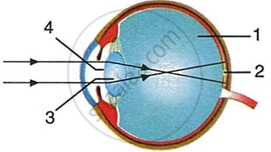Advertisements
Advertisements
प्रश्न
Explain the Term: Hypermetropia
उत्तर
With age, the elasticity of the lens decreases, and the individual becomes long-sighted and is called Hypermetropia In this condition, the diameter of the eyeball from front to back is too short. The clear image falls beyond the retina and the eye sees a blurred image. Hypermetropia may be corrected by the use of a biconvex lens.
APPEARS IN
संबंधित प्रश्न
Name the defect of vision in a person:
whose far point is less than infinity
Name the defect of vision which makes the eye-lens cloudy resulting in blurred vision.
What is the far point of a person suffering from myopia (or short-sightedness)?
Where is the near point of a person suffering from hypermetropia (or long-sightedness)?
A man can read the number of a distant but clearly but he finds difficulty in reading a book.
From which defect of the eye is he suffering?
Name the defect of vision which can be corrected by a converging lens. Show clearly by a ray diagram how the lens corrects the defect.
Explain with the help of labelled ray diagram, the defect of vision called myopia and how it is corrected by a lens.
A person having short-sight cannot see objects clearly beyond a distance of 1.5 m. What would be the nature and power of the corrective lens to restore proper vision?
A person cannot see the distant objects clearly (though he can see the nearby objects clearly). He is suffering from the defect of vision called:
(a) cataract
(b) hypermetropia
(c) myopia
(d) presbyopia
A person cannot read newspaper placed nearer than 50 cm from his eyes. Name the defect of vision he is suffering from. Draw a ray diagram to illustrate this defect. List its two possible causes. Draw a ray diagram to show how this defect may be corrected using a lens of appropriate focal length.
The near point of the eye of a person is 50 cm. Find the nature and power of the corrective lens required by the person to enable him to see clearly the objects placed at 25 cm from the eye?
Differentiate between:
Short-sightedness and Long-sightedness.
Give Technical Term:
The path which responsible for protecting the eye from sweat.
Complete the following sentence with appropriate word :
An inability to focus on nearby objects due to loss of elasticity of the lens with age is called Iris.
With respect to human eye explain:
(i) How is the image formed on the retina?
(ii) How is the amount of light entering the eye-controlled?
(iii) What type of lens is used for the correction of ‘Long sight’ defect?
(iv) With the help of a ray, diagram show the defect of the eye and then its correction after the use of a lens.
Myopia may arise due to ____________.
Correlate the given sequence:
Hypermetropia : Convex lens : ______ : Concave lens
Given alongside is a diagram depicting a defect of the human eye. Study the same and answer the questions that follow:
 |
- Name the defect shown in the diagram.
- Give two possible reasons for this defect.
- Name the parts labelled 1 to 4.
- Name the type of lens used to correct this eye defect.
- Draw a labelled diagram to show how the above mentioned defect is rectified using the lens named above.
